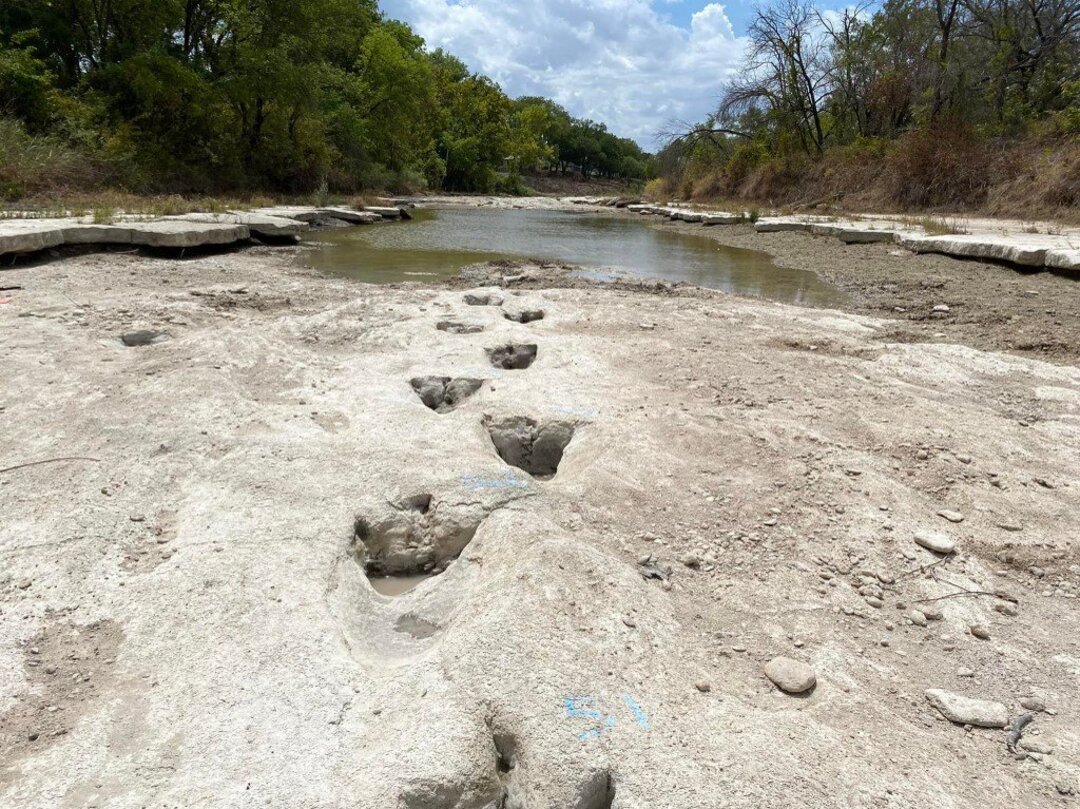-
Dinosaur tracks revealed after Texas drought dries up river

Images shared by Dinosaur Valley State Park show dinosaur tracks from around 113 million years ago, discovered in the Texas State Park after severe drought conditions that dried up a river, the park said Monday (August 22) in a statement.
Park spokesperson Stephanie Salinas Garcia told CNN in an email: "Most tracks that have recently been uncovered and discovered at different parts of the river in the park belong to Acrocanthosaurus. This was a dinosaur that would stand, as an adult, about 15 feet tall and (weigh) close to seven tons."
The other species that left tracks behind at the park in Glen Rose, Texas, was Sauroposeidon, which would be about 60 feet tall and weigh about 44 tons as an adult, Garcia mentioned.
"Being able to find these discoveries and experience new dinosaur tracks is always an exciting time at the park!" Garcia added.
Photos posted on Facebook show three-toed footprints leading down a dry tree-lined riverbed in the southern US state. It is "one of the longest dinosaur trackways in the world," a caption accompanying the images says.
Tracks of a 60-foot dinosaur, 113 million years old, just discovered on a dried-out riverbed at Dinosaur Valley State Park in Texas
— Scott Galloway (@profgalloway) August 23, 2022
(@cnn) pic.twitter.com/n6RqA04ZqE
This summer's excessive drought has caused a river in the park to dry out completely in most spots, revealing the tracks -- the latest long-hidden secret recently exposed as bodies of water have dried up due to drought conditions across the globe.
More than 60% of Texas was experiencing drought last week in two of the most intense categories, according to the US Drought Monitor.
UNICEF: Drought in parts of Africa puts children "one disease away from catastrophe"
The state also recently has experienced heat waves that pushed temperatures into the triple digits, leaving millions under excessive heat alerts.
Meanwhile, the tracks are expected to be buried again as rain is forecast, said Garcia, who added the process helps protect the tracks from natural weathering and erosion.
levantnews-agencies
You May Also Like
Popular Posts
Caricature
BENEFIT Sponsors BuildHer...
- April 23, 2025
BENEFIT, the Kingdom’s innovator and leading company in Fintech and electronic financial transactions service, has sponsored the BuildHer CityHack 2025 Hackathon, a two-day event spearheaded by the College of Engineering and Technology at the Royal University for Women (RUW).
Aimed at secondary school students, the event brought together a distinguished group of academic professionals and technology experts to mentor and inspire young participants.
More than 100 high school students from across the Kingdom of Bahrain took part in the hackathon, which featured an intensive programme of training workshops and hands-on sessions. These activities were tailored to enhance participants’ critical thinking, collaborative problem-solving, and team-building capabilities, while also encouraging the development of practical and sustainable solutions to contemporary challenges using modern technological tools.
BENEFIT’s Chief Executive Mr. Abdulwahed AlJanahi, commented: “Our support for this educational hackathon reflects our long-term strategic vision to nurture the talents of emerging national youth and empower the next generation of accomplished female leaders in technology. By fostering creativity and innovation, we aim to contribute meaningfully to Bahrain’s comprehensive development goals and align with the aspirations outlined in the Kingdom’s Vision 2030—an ambition in which BENEFIT plays a central role.”
Professor Riyadh Yousif Hamzah, President of the Royal University for Women, commented: “This initiative reflects our commitment to advancing women in STEM fields. We're cultivating a generation of creative, solution-driven female leaders who will drive national development. Our partnership with BENEFIT exemplifies the powerful synergy between academia and private sector in supporting educational innovation.”
Hanan Abdulla Hasan, Senior Manager, PR & Communication at BENEFIT, said: “We are honoured to collaborate with RUW in supporting this remarkable technology-focused event. It highlights our commitment to social responsibility, and our ongoing efforts to enhance the digital and innovation capabilities of young Bahraini women and foster their ability to harness technological tools in the service of a smarter, more sustainable future.”
For his part, Dr. Humam ElAgha, Acting Dean of the College of Engineering and Technology at the University, said: “BuildHer CityHack 2025 embodies our hands-on approach to education. By tackling real-world problems through creative thinking and sustainable solutions, we're preparing women to thrive in the knowledge economy – a cornerstone of the University's vision.”
opinion
Report
ads
Newsletter
Subscribe to our mailing list to get the new updates!






















